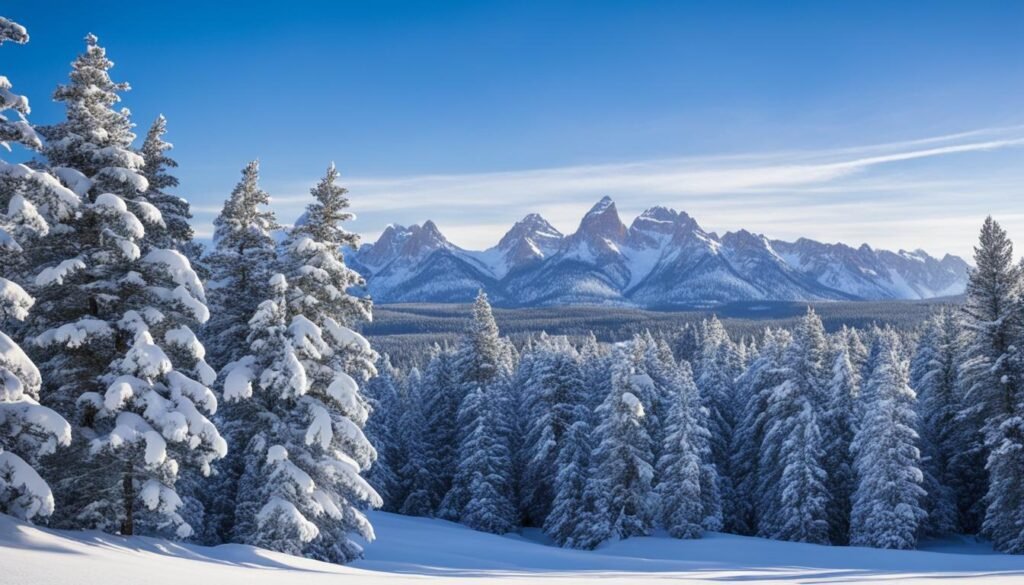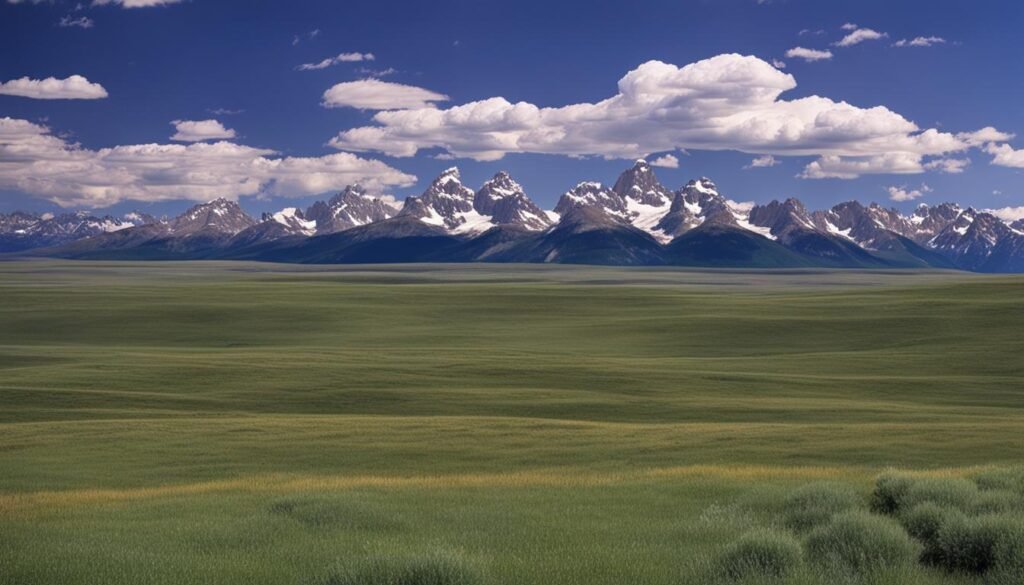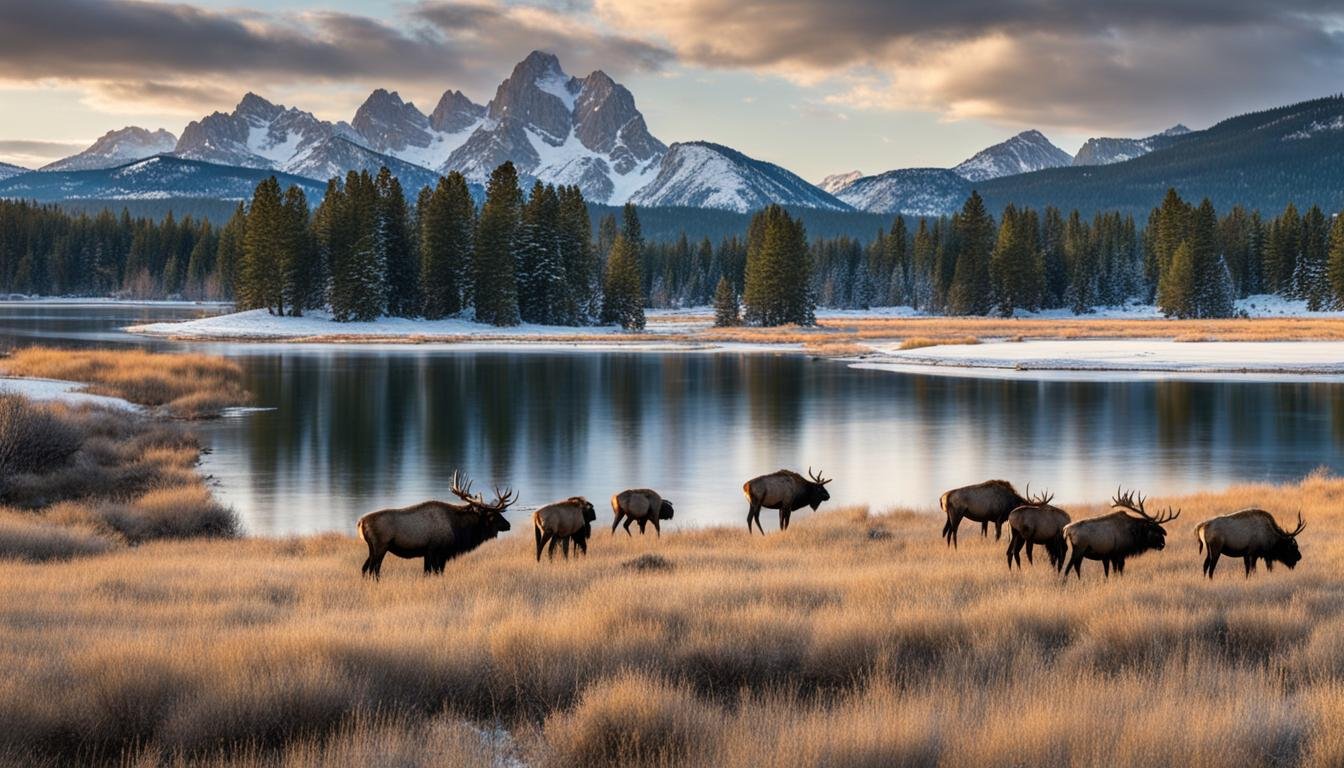When it comes to winter wonderlands, Wyoming is a destination that doesn’t disappoint. With its stunning landscapes and high elevation, the state experiences snowfall throughout the winter season. So if you’re wondering, “Does it snow in Wyoming?” the answer is a resounding yes!
From October to May, Wyoming is adorned with a beautiful white blanket of snow. The snowfall begins as early as late September in the lower elevations and continues well into the spring months. Whether you’re exploring the majestic mountains or the vast plains, you’re likely to encounter the magic of winter in Wyoming.
Wyoming’s snowfall patterns vary across the state, with some regions experiencing heavier snowfall than others. The snowiest months vary widely, with March and April being favored east of the Continental Divide. The Bighorn Mountains receive significant snowfall, with accumulations of 10 to 15 inches or more from a single storm.
When winter storms hit Wyoming, they can bring blizzard or near blizzard conditions. High winds, low temperatures, and moderate to heavy snow/blowing snow create challenging winter conditions. It’s important to stay informed and prepared to ensure your safety during these snowstorms.
So if you’re planning a winter adventure in Wyoming, make sure to pack your warmest gear and get ready to embrace the snowy wonders that this beautiful state has to offer.
Key Takeaways:
- Wyoming experiences snowfall from October to May.
- The snowiest months vary across the state, with March and April being favored east of the Continental Divide.
- The Bighorn Mountains receive significant snowfall, with accumulations of 10 to 15 inches or more from a single storm.
- Winter storms in Wyoming can bring blizzard or near blizzard conditions, with high winds, low temperatures, and moderate to heavy snow/blowing snow.
- Stay informed and prepared for winter conditions to ensure your safety.
Wyoming Winter Weather Awareness Day
The National Weather Service (NWS) offices in Wyoming organize an annual event called Wyoming Winter Weather Awareness Day. This event aims to educate residents about safety rules and preparedness during winter storms, providing valuable information to help them navigate the challenging winter weather conditions.
During Wyoming Winter Weather Awareness Day, the NWS emphasizes the importance of being aware of snowstorm warnings in Wyoming and understanding winter storm safety. It is crucial for residents to stay informed about potential snowstorms and blizzard conditions that may impact their area.
Winter storm warnings are disseminated through various channels to reach as many people as possible. These channels include NOAA All-Hazards Weather Radio, local television and radio stations, cable television systems, and the internet. The goal is to ensure that residents have access to timely and accurate information to make informed decisions and take necessary precautions.
Residents are encouraged to familiarize themselves with safety guidelines provided by the NWS and other relevant authorities. These guidelines cover a range of topics, including how to prepare for winter storms, what to do during a snowstorm, and how to protect themselves and their families. It is recommended to have an emergency plan in place, stocked with essential supplies like food, water, and medications.
By participating in Wyoming Winter Weather Awareness Day and following the guidance provided, residents can better prepare for winter storms and ensure their safety during challenging weather conditions.
Winter Storm Safety Tips:
- Stay informed by regularly checking weather updates and warnings from the National Weather Service.
- Create an emergency kit with essential supplies, including food, water, medications, and warm clothing.
- Prepare your home for winter by insulating pipes, sealing drafts, and stocking up on heating fuel.
- Have a communication plan in place to stay connected with family members and friends during a snowstorm.
- Avoid unnecessary travel during winter storms. If you must travel, ensure your vehicle is equipped with emergency supplies and a full tank of gas.
- Stay indoors during blizzard conditions and avoid unnecessary exposure to extreme cold and wind.
- If you need to go outside, dress in layers, wear a hat and gloves, and cover exposed skin to prevent frostbite.
- Take precautions when using alternative heating sources to prevent carbon monoxide poisoning.
Snowfall Averages in Wyoming
Wyoming experiences varying snowfall amounts throughout the state. Monthly snowfall averages differ across cities in Wyoming. For example, Casper has an average snowfall of 76.4 inches per season, while Cheyenne has an average snowfall of 56.4 inches per season. The snowiest months tend to be in March and April for many locations, although some cities like Buffalo, Cody, and Torrington have a more evenly distributed monthly average snowfall between December and April.
To give you a better idea of the snowfall averages in Wyoming, here is a table showcasing the monthly snowfall averages in selected cities:
| City | December | January | February | March | April | Season Total |
|---|---|---|---|---|---|---|
| Casper | 11.9″ | 8.4″ | 9.0″ | 9.6″ | 8.2″ | 76.4″ |
| Cheyenne | 16.6″ | 11.5″ | 8.5″ | 7.9″ | 12.6″ | 56.4″ |
| Buffalo | 12.8″ | 9.1″ | 9.4″ | 10.2″ | 8.1″ | 65.8″ |
| Cody | 15.0″ | 9.6″ | 9.8″ | 8.5″ | 6.9″ | 59.8″ |
| Torrington | 8.5″ | 7.3″ | 7.2″ | 8.0″ | 8.2″ | 47.2″ |
The above table provides insight into the monthly snowfall averages for selected cities in Wyoming. As you can see, the snowfall amounts can vary significantly from one city to another, with some cities experiencing heavier snowfall in December and January, while others see more snow later in the season. It’s important to keep in mind that these are average values and actual snowfall amounts can vary from year to year.
Winter Weather Conditions in Wyoming

Winter weather conditions in Wyoming can be quite harsh and challenging. The state is known for its severe winter conditions, characterized by high winds, low temperatures, and heavy snowfall. Blizzards or near blizzard conditions can often last for a day or two, but rarely longer than three days.
During snowstorms, strong winds accompany the snowfall, leading to the piling up of snow in deep drifts, sometimes several feet high. The combination of these harsh elements can create treacherous conditions, making travel difficult and posing hazards to residents.
Some areas in Wyoming, particularly the western valleys, experience the heaviest snowfall from December through early March. This is due to the westerly flow off the Pacific Ocean, which brings moisture-laden storms into the region. The result is significant snow accumulation, contributing to the already challenging winter conditions.
However, it is important to note that not all areas in Wyoming experience the same winter weather conditions. The state’s topography and precipitation shadow effects can lead to variations in snowfall amounts and drier conditions in certain areas, especially east of the mountains.
It is crucial for residents and visitors in Wyoming to stay informed about winter weather forecasts and heed any warnings or advisories issued by local authorities and the National Weather Service. By being prepared and taking necessary precautions, individuals can navigate the winter season more safely and minimize the risks associated with severe weather conditions.
Precautions for Winter Weather Conditions:
- Dress warmly in layers to protect against the cold temperatures.
- Use appropriate winter gear such as hats, gloves, and boots to prevent frostbite.
- Prepare an emergency kit containing essentials like food, water, blankets, and flashlights.
- Stay updated with weather forecasts and road conditions before traveling.
- Avoid unnecessary travel during blizzard conditions or when weather conditions are hazardous.
- If driving is necessary, ensure your vehicle is properly equipped with snow tires or chains.
- Keep a safe distance from other vehicles and drive at a speed suitable for the conditions.
- Notify friends or family of your travel plans and expected arrival time.
- Stay informed through local news sources and emergency management agencies.
Wyoming Climate and Topography

Wyoming’s climate is strongly influenced by its diverse topography, which showcases majestic mountains and expansive high plains. The state’s average elevation is around 6,700 feet above sea level, creating unique weather patterns and climatic conditions.
The mountain ranges in Wyoming act as natural barriers to air currents, causing them to ascend and release moisture along the western slopes. This phenomenon contributes to the relatively wetter climate on the western side of the state, while the eastern regions are considered semi-arid.
The Continental Divide splits Wyoming, with most drainage areas located to the east. This geographical division affects precipitation patterns, resulting in drier conditions in certain areas east of the mountains.
Wyoming’s elevation also plays a significant role in shaping its climate. The state’s relatively high elevation leads to cooler temperatures, especially during the winter season. Rarely does Wyoming experience temperatures exceeding 100°F, making it a haven from scorching summer heat.
The short growing season in Wyoming is a consequence of early fall freezes and late spring freezes. These climatic characteristics affect agriculture and the types of crops that can be cultivated in the state.
Average Temperature and Precipitation in Select Wyoming Cities
| City | Average High (°F) | Average Low (°F) | Average Annual Precipitation (in) |
|---|---|---|---|
| Cheyenne | 58.9 | 32.0 | 15.7 |
| Casper | 56.9 | 30.9 | 13.6 |
| Laramie | 53.4 | 27.7 | 12.1 |
Note: The above table showcases the average temperatures and annual precipitation for select cities in Wyoming. These figures provide a general understanding of the climate patterns, but it’s important to note that weather conditions can vary within the state.
Understanding Wyoming’s climate and topography is key to appreciating the unique weather conditions experienced in the state. The combination of high elevation, mountainous terrain, and semi-arid plains contributes to the diverse and at times unpredictable climate that shapes Wyoming’s natural beauty.
Conclusion
During the winter season in Wyoming, residents can expect snowfall from late September through May. The snowiest months, typically March and April, bring heavy snowfall, especially in the Bighorn Mountains. It is important for residents to stay informed about winter weather conditions and take necessary precautions to ensure their safety during snowstorms. The National Weather Service provides valuable warnings and information to help navigate the challenges of winter weather in Wyoming.
With varying amounts of snowfall across the state, it is important to be prepared for winter conditions. Whether you live in Casper, Cheyenne, Lander, or any other city in Wyoming, understanding the winter forecast can help you plan accordingly. From stocking up on supplies to staying updated with weather alerts, being proactive can make a significant difference in your winter experience.
When it comes to navigating snowy conditions, remember to drive carefully and allow extra time for travel. Additionally, keep a winter emergency kit in your vehicle and dress warmly when venturing outdoors. By taking these precautions and staying informed, you can make the most of the beautiful winter season in Wyoming while staying safe and prepared for whatever the weather brings.
FAQ
Does it snow in Wyoming?
Yes, Wyoming experiences snowfall during the winter season.
When does snowfall occur in Wyoming?
Snowfall in Wyoming typically begins as early as late September and can continue through May.
Which months are the snowiest in Wyoming?
The snowiest months in Wyoming tend to be March and April.
What are the snowfall averages in Wyoming?
Monthly snowfall averages vary across cities in Wyoming, with Casper, Cheyenne, and Lander having the highest snowfall amounts.
What are the winter weather conditions in Wyoming?
Winter weather conditions in Wyoming can be severe, with high winds, low temperatures, and heavy snowfall. Blizzards or near blizzard conditions can occur due to these factors.
How is Wyoming’s climate influenced by its topography?
Wyoming’s climate is influenced by its topography, with the state characterized by majestic mountains and high plains. The mountain ranges in Wyoming act as barriers to air currents, forcing them to rise and drop moisture along the western slopes.
Is there a Winter Weather Awareness Day in Wyoming?
Yes, the National Weather Service (NWS) holds an annual Winter Weather Awareness Day in Wyoming to educate residents about safety rules and preparedness during winter storms.
How are winter storm warnings disseminated in Wyoming?
Winter storm warnings in Wyoming are disseminated through various channels such as NOAA All-Hazards Weather Radio, local television and radio stations, cable television systems, and the internet.
What should residents do to prepare for winter storms?
Residents are encouraged to familiarize themselves with safety guidelines and make plans to protect themselves and their families during winter storms in Wyoming.
What is the elevation in Wyoming?
The average elevation in Wyoming is around 6,700 feet above sea level.
How does Wyoming’s elevation affect its climate?
Wyoming has a relatively cool climate due to its elevation, with rare occurrences of temperatures exceeding 100°F. The growing season in Wyoming is short due to early fall freezes and late spring freezes.

Leave a Reply